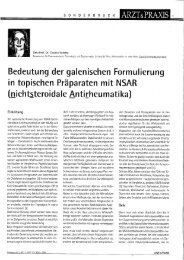Diclofenac Sodium 4% Spray Gel - cyathus.cz
Diclofenac Sodium 4% Spray Gel - cyathus.cz
Diclofenac Sodium 4% Spray Gel - cyathus.cz
You also want an ePaper? Increase the reach of your titles
YUMPU automatically turns print PDFs into web optimized ePapers that Google loves.
PAR <strong>Diclofenac</strong> <strong>Sodium</strong> <strong>4%</strong> <strong>Spray</strong> <strong>Gel</strong><br />
UK/H/0562-3/001/E01<br />
Children<br />
The use in children under the age of 15 years is not assessed and therefore not<br />
recommended.<br />
Patients with hepatic or renal insufficiency<br />
For the use of <strong>Diclofenac</strong> <strong>Sodium</strong> 4 % <strong>Spray</strong> <strong>Gel</strong> in patients with hepatic or<br />
renal insufficiency see section 4.4.<br />
4.3 Contra-indications<br />
Hypersensitivity to diclofenac, acetylsalicylic acid or other non-steroidal antiinflammatory<br />
drugs (NSAIDs) or any excipients of the finished medicinal<br />
product.<br />
Patients with or without asthma in whom attacks of asthma, urticaria or acute<br />
rhinitis are precipitated by aspirin or other non-steroidal anti-inflammatory<br />
agents.<br />
In the last trimester of pregnancy.<br />
4.4 Special warning and precautions for use<br />
Patients should be warned against excessive exposure to sunlight in order to<br />
reduce the incidence of photosensitivity. Discontinue if any rash develops. Not<br />
for use with occlusive dressings.<br />
<strong>Diclofenac</strong> <strong>Sodium</strong> 4 % <strong>Spray</strong> <strong>Gel</strong> should only be administered onto intact<br />
skin, not on open wounds or diseased skin areas. Contact with eyes and<br />
mucous membranes as well as oral use should be avoided.<br />
The concomitant use of <strong>Diclofenac</strong> <strong>Sodium</strong> 4 % <strong>Spray</strong> <strong>Gel</strong> with oral NSAIDs<br />
should be cautioned as the incidence of systemic side effects may increase (see<br />
interactions).<br />
Where <strong>Diclofenac</strong> <strong>Sodium</strong> 4 % <strong>Spray</strong> <strong>Gel</strong> is applied to a relatively large area<br />
of skin (i.e. more than 600 square centimetres of the body surface) and over a<br />
prolonged period (i.e. more than 4 weeks), the possibility of systemic sideeffects<br />
cannot be completely excluded. If such usage is envisaged, the data<br />
sheet on diclofenac oral dosage forms should be consulted (for example, there<br />
is the potential for hypersensitivity, asthmatic and renal adverse reactions).<br />
Bronchospasm may be precipitated in patients suffering from or with previous<br />
history of bronchial asthma or allergenic disease.<br />
<strong>Diclofenac</strong> <strong>Sodium</strong> 4 % <strong>Spray</strong> <strong>Gel</strong> should only be used with caution in<br />
patients with a history of peptic ulcer, hepatic or renal insufficiency, or<br />
bleeding diathesis, or inflammatory bowel disease, as isolated cases with<br />
topical diclofenac have been reported.<br />
<strong>Diclofenac</strong> <strong>Sodium</strong> 4 % <strong>Spray</strong> <strong>Gel</strong> contains propylene glycol which may cause<br />
skin irritation.<br />
6



